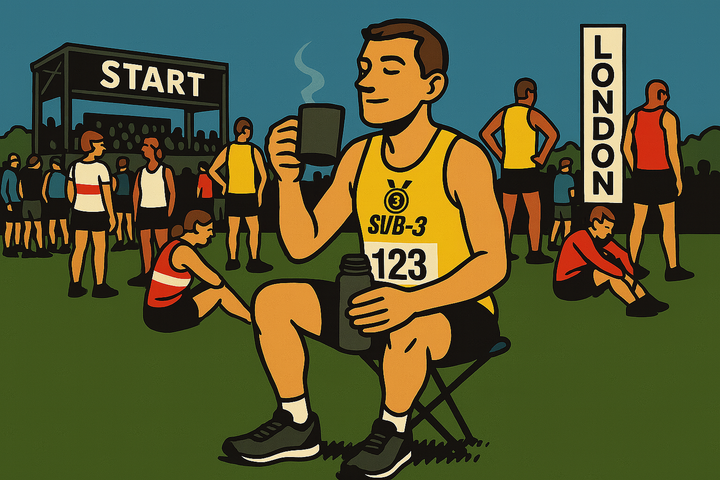Should I try to go sub-3 overseas?
A flat course in Berlin or Valencia might tempt you - but overseas marathons come with extra risks. Here’s how to stack the odds in your favour when racing abroad.

There comes a point in many marathoners’ lives when the call of the big races grows louder - the World Marathon Majors, the fast European classics, the chance to combine a personal best with a passport stamp. Becoming one of the elusive Six Star finishers (or now seven, as Abbott World Marathon Majors expands) holds undeniable appeal. And for some, the ultimate prize is not just finishing them all, but going sub-3 at each one.
Even for first-time sub-3 aspirants, the overseas temptation is strong. Berlin’s pancake-flat course, Valencia’s cool weather and peerless pacing, Seville’s uncrowded historic route - these races are designed for fast times.
But while chasing a perfect course abroad can boost your chances, it’s not without risk. Unless you’re a seasoned international racer, the added complexity of travel can do more harm than good. Here are ten things to consider if you're planning to go sub-3 overseas.
1. Don’t go sightseeing the day before
It sounds obvious, but many runners throw it all away with 20,000 sightseeing steps the day before race day. Walking around Prague Castle, wandering the Louvre or climbing the Spanish Steps might feel “light” at the time - but your legs will notice the next morning. Stay off your feet. Resist the lure of the pre-race 5K. Your hotel bed, a film and some plain carbs are a much better bet.
2. Collect your number early - queues can be brutal
Almost all overseas marathons require number collection at a race expo, which can be located well outside the city centre. Queues are often long, especially the day before, and many have strict cut-off times. Get it done early and beat the rush. This is the one bit of sightseeing you can’t skip.
3. Acclimatise - or simulate at home
If you're racing in a different climate - hotter, drier or more humid - give your body time to adjust. Ideally, arrive early. If that’s not possible, short sauna sessions during taper week can help with heat adaptation. Even two or three 15-minute dry sauna sessions after easy runs can simulate the thermoregulation demands of racing in a warmer climate like Dubai or Singapore.
4. Keep food familiar
Yes, the gnocchi in Rome looks spectacular. And yes, the pintxos in San Sebastián smell divine. But race weekend isn’t the time to experiment. Stick to simple, familiar foods. Aim to replicate your home pre-race meals as closely as possible. Save the culinary adventure for post-race celebrations.
5. Think ahead with jet lag
Jet lag can undermine even the best build-up. If crossing time zones, try to get on the destination schedule a few days early. That may mean setting your alarm at 5am in the UK to mimic Tokyo mornings. Prioritise sleep in the days leading up to departure. A tired runner is a fragile one.
6. Bring the essentials, not just your passport
If you rely on a particular brand of bagel, a specific peanut butter or an electrolyte drink that isn’t widely available, bring it with you. Don’t assume local shops will stock what you need. Customs rules vary, so check before you pack. The rule of thumb remains: nothing new on race day.
7. Pack your kit in hand luggage
This one’s non-negotiable. Put your race shoes, shorts, socks, gels and lucky vest in your carry-on. If your luggage goes missing, your goal won’t have to. You do not want to be hunting for Alphaflys in a strange city the night before the race. It happens more than you think.
8. Save the socialising until afterwards
Meeting friends abroad is a bonus - but beware the night-before pint, or hours of excited chat when you should be winding down. Race-eve should be quiet, calm and focused. This is the moment to disappear to your room, do some yoga or stretching, and give yourself the mental space to prepare. There’ll be time for tapas and toasts tomorrow.
9. Sort your airport transit in advance
A marathon weekend can turn even the smoothest city into a transport snarl. Airport taxi queues in places like Barcelona or Boston can stretch for hours on race weekend. Pre-book a transfer, or research your public transport options in detail. Don’t leave it to chance. Stress is cumulative - and unnecessary queues add more than you think.
10. Study the course - seriously
You wouldn’t go into a local marathon blind. So don’t do it abroad. Watch YouTube recces, read race reports, pore over elevation charts. The more familiar your brain is with the course, the more it can filter out the noise and help you focus on performance. Whether you’re gliding past the Brandenburg Gate or looping through Tokyo suburbs, a little visualisation goes a long way.
Going sub-3 overseas is absolutely possible - and the sense of occasion can give you that final push to make it happen. But it also brings added variables: time zones, stress, logistics and cost. If your primary goal is a sub-3 rather than a travel experience, you may actually fare better on a slightly tougher course closer to home, where everything is more familiar and controllable.
That said, there’s nothing quite like hearing your name mispronounced as you cross the finish line in a foreign city with a time starting with a 2. It might just be worth the leap.
Enjoyed this article? Help keep Sub-3 running — support us with a coffee.
To help fund the running of the site, Sub-3 is an Amazon Associate and earns from qualifying purchases. We only recommend gear or kit that has genuinely helped in our own running and that we believe is worth considering.



